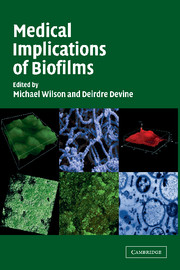Book contents
- Frontmatter
- Contents
- Preface
- List of Contributors
- PART ONE INTRODUCTORY CHAPTERS
- PART TWO BIOFILMS ON PROSTHETIC DEVICES
- PART THREE ORAL BIOFILMS
- PART FOUR BIOFILMS ON SHEDDING SURFACES
- 11 Dissection of the Genetic Pathway Leading to Multicellular Behaviour in Salmonella enterica Serotype Typhimurium and Other Enterobacteriaceae
- 12 Bacterial Growth on Mucosal Surfaces and Biofilms in the Large Bowel
- 13 Pseudomonas aeruginosa Biofilms in Lung Infections
- Index
- References
11 - Dissection of the Genetic Pathway Leading to Multicellular Behaviour in Salmonella enterica Serotype Typhimurium and Other Enterobacteriaceae
Published online by Cambridge University Press: 23 November 2009
- Frontmatter
- Contents
- Preface
- List of Contributors
- PART ONE INTRODUCTORY CHAPTERS
- PART TWO BIOFILMS ON PROSTHETIC DEVICES
- PART THREE ORAL BIOFILMS
- PART FOUR BIOFILMS ON SHEDDING SURFACES
- 11 Dissection of the Genetic Pathway Leading to Multicellular Behaviour in Salmonella enterica Serotype Typhimurium and Other Enterobacteriaceae
- 12 Bacterial Growth on Mucosal Surfaces and Biofilms in the Large Bowel
- 13 Pseudomonas aeruginosa Biofilms in Lung Infections
- Index
- References
Summary
INTRODUCTION
Many environmental as well as host-associated microorganisms not only live as single independent cells, but are able to interact with each other and to build multicellular communities, whose architecture is determined by a self-produced extracellular matrix. Also, in the family Enterobacteriaceae, different types of multicellular behaviour have been identified, for example, in Salmonella enterica serotype Typhimurium (S. typhimurium) and Escherichia coli (Harshey and Matsuyama, 1994; Romling et al., 1998a). The rdar (red, dry and rough colony morphology) morphotype (Figure 11.1, first identified in S. enterica serotype Typhimurium (Romling et al., 1998a), represents a characteristic multicellular behaviour of S. enterica serotypes (Salmonella spp.) and E. coli in the late stationary phase of growth (Zogaj et al., 2001). Life within a community, compared with planktonic growth, is significantly different for S. enterica serotype Typhimurium and E. coli with respect to, for instance, cell density, nutrient supply, and production of architectural components (extracellular matrix formation); cell–cell communication, gene expression, and regulation are altered on various levels (Pringent-Combaret et al., 2001; Zogaj et al., 2001). An additional regulatory network, under tight control by environmental conditions, is required to coordinate the transition from the multicellular to the free-living form (Gerstel and Romling, 2001). Novel regulatory pathways involving genes with signalling domains of unknown function are part of this network (Romling et al., 2000). The impact of multicellular behaviour on the life cycle of S. enterica and E. coli has not been unambiguously proven.
- Type
- Chapter
- Information
- Medical Implications of Biofilms , pp. 231 - 261Publisher: Cambridge University PressPrint publication year: 2003
References
- 5
- Cited by



